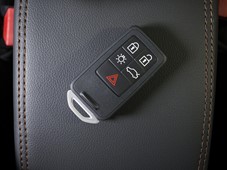By Eric Grange | December 19, 2017

As we explored previously, the modern car door handle requires sophisticated switch technology that empowers automotive designers to feel confident that components failure won’t occur since it could interfere with significant vehicle functions, such as door lock for a passive entry system, or worse, door aperture for a car with new electrical latches.
You’d be surprised at how many different components, systems, and other features go into the composition and operation of a car door handle – car door handles may protrude from the vehicle's exterior surface or be streamlined into the vehicle's contour. In some automobiles, especially luxury vehicles, the door handles may feature a key-less entry pad utilizing either a numerical code or thumb scan.
A key (no pun intended) car door handle element that we will explore further in this post is the key fob.
Today’s door handles can be paired with modern key fobs allowing users to open and lock a car door remotely, and typically take shape as small plastic controllers. Key fobs contain a short-range radio transmitter, and must be within a certain range of the car to work. When a button is pushed, it sends a coded signal by radio waves to a receiver unit in the car, which locks or unlocks the door.
Depending on the make, model, and/or age of a car, key fobs can have any number or type of buttons situated on their plastic shells. These buttons are used to lock or unlock doors, trunks or other vehicle entry points.
In some cars, key fobs can also be used to close and open the windows and/or retractable roofs. Some fobs also come equipped with a panic button to activate the car alarm as a safety feature.
No matter how many buttons that sit on a key fob, or the operations the fob is required to perform, the switches that power these functions and make them run smoothly must be small enough to fit snuggly on the fob’s surface area – after all, users don’t want to carry around overly bulky fobs all day in their purses or pockets.
Key fob switches must also be durable enough to withstand outside elements, such as wind, rain and accidents that leave doors dented in. Indoor elements pose a risk, too – fobs can accidentally get mixed in with laundry and take a ride in the washing machine when left inside a trouser pocket. C&K has a lineup of miniature tactile switches that are the perfect size to fit compactly inside key fobs and door handles, and are rugged enough that they don’t wear out from constant use or the harsh weather conditions cars must endure.
Designers also need to ensure that the key fob’s tactile feedback works properly since the materials that make up its protective shell – plastic and silicone – can absorb a significant part of the switch’s tactile response. Using the highest force on the market, C&K switches manage enough tactile feedback, without compromising the product’s robustness and lifecycle.
Because key fobs are equipped with a short-range radio transmitter, designers also need to adhere to radio emission regulations, so any manufacturer’s modification to the key fob is subject to government review and qualification.
With so many automotive brands opting for doors that operate remotely with key fobs, the design challenges associated with tactile feedback and radio emission regulations, and the sheer number of switch combinations per vehicle that can affect pricing, there is an even greater need for high-quality and customizable switches, like those from C&K, to power these innovative functions.
With its unmatched custom design capabilities, C&K can tailor switches for each individual key fob, based on customer need, government regulation, and at competitive prices.

Eric Grange
Global Segment Manager
Automotive
